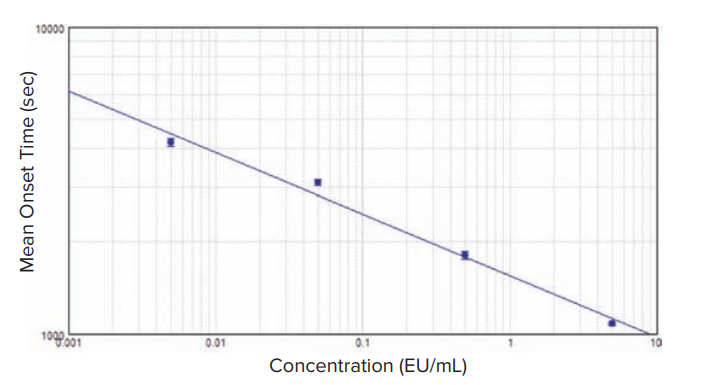
Application Note
Detect endotoxin with the Kinetic-QCL Kinetic Chromogenic LAL Assay
- Sensitive detection of endotoxin down to 0.005 EU/mL
- Chromogenic alternative to gel clot methods
- Automated data reduction and analysis with pre-configured protocols in SoftMax® Pro Software
Joyce Itatani | Application Scientist | Molecular Devices
Cathy Olsen, PhD | Sr. Applications Scientist | Molecular Devices
Monitoring for contaminants is a critical step during the production process in the pharmaceutical and medical device industries. A frequent contaminant, endotoxin, can cause fever, inflammation, headache, nausea, and even death. Found in the cell wall of gram-negative bacteria, endotoxin has routinely been detected by the sensitive and specific Limulus Amebocyte Lysate (LAL) assay. In the presence of endotoxins, LAL coagulates through an enzyme-mediated cascade, which has then been traditionally quantified based on gelation and turbidity.
The Kinetic-QCL™ Kinetic Chromogenic LAL Assay from Lonza utilizes the initial part of the LAL endotoxin reaction, activating an enzyme that releases p-nitroaniline (pNA) from a synthetic substrate to produce a yellow color that is detected by its absorbance at 405 nm. This chromogenic readout is well suited to testing inhibitory products that can interfere with the clotting mechanism in turbidimetric assays. This absorbance can be measured using a microplate reader and is proportional to the endotoxin concentration in the sample. Here we show how the SpectraMax® Mini Multi-Mode Microplate Reader can be used in endotoxin quantitation.
Materials
- Kinetic-QCL
- ™
- Kinetic Chromogenic LAL Assay (Lonza cat. #50-650U), including the following reagents:
- Kinetic-QCL Reagent
- LAL Reagent Water
- E. coli O55:B5 Endotoxin (Control Standard Endotoxin for this kit)
- 96-well clear LAL Reagent Grade Multi-Well Plates (Lonza cat. #25-340)
- Pyrogen-free Dilution Tubes (Lonza cat. #N207)
- SpectraMax Mini Multi-Mode Microplate Reader (Molecular Devices cat. #SMAX MINI AFL, SMAX MINI AF, or SMAX MINI AL)
Methods
The SpectraMax Mini reader was heated to 37°C via the SoftMax Pro Software user interface prior to setting up the assay.
Control Standard Endotoxin was reconstituted with LAL Reagent Water (LRW), as indicated on the Certificate of Analysis included with the kit, to yield a solution of 50 EU/mL. The vial was vortexed vigorously for 15 minutes. The Kinetic-QCL Reagent was reconstituted with LAL Reagent Water according to kit instructions. The vial was swirled gently to avoid foaming.
A series of endotoxin standards was prepared in disposable endotoxin-free glass dilution tubes. A 1:10 dilution series, from 5 EU/mL down to 0.005 EU/mL, was made in LRW. 100 µL of each standard was added to duplicate wells of an LAL Reagent Grade Multi-Well Plate. The microplate was incubated at 37°C in the preheated SpectraMax Mini reader for 10 minutes. 100 µL of Kinetic-QCL Reagent was then dispensed into the wells of the microplate containing the endotoxin standards using a multi-channel pipettor. The kinetic read was started immediately using a pre-configured protocol in SoftMax Pro Software, with settings indicated in Table 1. Absorbance data at 405 nm were acquired every minute for two hours and displayed in real time in the software’s plate section. The interval and run times may be adjusted as needed.
Total run time: 02:00:00B
Interval: 00:01:00
Before first read: 10 sec
- Shake intensity: Medium
- Shake mode: Dbl. Orbital
Between reads: 5 sec
- Shake intensity: Medium
- Shake mode: Dbl. Orbital
Table 1. Instrument settings for LAL Kinetic-QCL assay on the SpectraMax Mini reader
An automatic data reduction was applied in SoftMax Pro Software to calculate the onset time, also known as reaction time, for each well. The onset optical density (OD) was set to 0.2 as indicated in the kit manual. The onset time is the time required for the absorbance of the well to increase by the specified onset OD, or 0.2 absorbance units. A log-log standard curve was constructed by plotting onset time vs. standard concentration.
Results
0.005 to 5 EU/mL are shown in Figure 1, with onset times indicated as vertical red lines. Mean onset time for each standard was plotted vs. standard concentration using a log-log curve fit in SoftMax Pro Software (Figure 2).

Figure 1. Instrument settings for LAL Kinetic-QCL assay on the SpectraMax Mini reader.

Figure 2. Endotoxin standard curve. Mean onset time (seconds) vs endotoxin standard concentration was plotted using the log-log curve fit in SoftMax Pro Software (n = 2, r2 = 0.987).
According to the LAL Kinetic-QCL assay manual, performance requirements include the following:
- The absolute value of the correlation coefficient (r) of the calculated standard curve should be ≥ 0.980.
- The %CV of the onset times for the standard replicates should be less than 10%.
For the standard curve generated using the SpectaMax Mini reader, SoftMax Pro Software calculated an r2 value of 0.987, exceeding the requirement for this assay. The %CV calculated by the software for standards in duplicate was less than 4% for each standard (Table 2).
Table 2. Values calculated in the standards group table in SoftMax Pro Software. %CV for each standard was less than 10, meeting the required reproducibility as indicated in the LAL Kinetic
Note: Equivalent results were obtained using the SpectraMax ABS Plus Microplate Reader (data not shown).
Conclusion
The generation of a linear standard curve with low variance between replicates and sensitivity down to the assay’s stated lower limit of detection demonstrates the suitability of the SpectraMax Mini reader and LAL KineticQCL Assay for detecting endotoxin in test samples. SoftMax Pro Software can automatically interpolate the endotoxin concentrations of unknowns from the standard curve based on sample onset times.